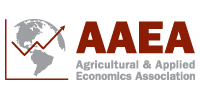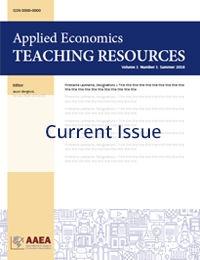Case Study
Applied Economic Models of Commodity and Input Markets to Assess Prices, Quantities, Farm and Other Input Supplier Impacts, and Consumer and Taxpayer Costs
Joe Dewbre(a), Wyatt Thompson(b), Sera Chiuchiarelli(b)
(a)Private Economist, (b)University of Missouri
JEL Codes: JEL Codes: A29, Q02, Q11
Keywords: Market model, market equilibrium, agricultural supplier impacts, corn, hogs, pork, winners and losers
Publish Date: May 30, 2024
Volume 6
View Full Article (PDF) | Request Teaching Notes/Supplemental Materials
Abstract
The impacts of exogenous market and policy developments reverberate up and down the farm to the retail marketing chain, affecting consumer prices, farm input prices, and the economic well-being of many people. Applied economists have developed analytical tools that trace how developments at one point in the supply chain may affect prices and quantities at other points. The particular analytical tools proposed here aim to provide students with hands-on experience in using market models and real data to simulate relevant policy and market scenarios. We start with a simple model representing only the supply and demand for corn and end with a vertically integrated model that links corn, hog, and pork markets. Each phase of model development gives a chance to build and test economic intuition about how price effects come about and their impacts on various market participants: who benefits and who pays—the winners and losers.
References
Brester, G., J. Atwood, and M. Boland. 2023. Equilibrium Displacement Models: Theory, Applications, and Policy Analysis. Minneapolis: University of Minnesota Libraries Publishing.
Brester, G., J. Marsh, and J. Atwood. 2004. “Distributional Impact of Country-of-Origin Labeling in the U.S. Meat Industry.” Journal of Agricultural and Resource Economics 29(2):206–277.
Dewbre, J., J. Anton, and W. Thompson. 2001. “Direct Payments, Safety Nets and Supply Response: The Transfer Efficiency and Trade Effects of Direct Payments.” American Journal of Agricultural Economics 83(5):1204–1214.
Floyd, J.E. 1965. “The Effects of Farm Price Supports on the Return to Land and Labour in Agriculture.” Journal of Political Economy 3:148–158.
Gardner, B. 1987. The Economics of Agricultural Policies. New York: Macmillan.
Global Trade Analysis Project. 2023. “GTAP Models: Current Model.” www.gtap.agecon.purdue.edu/models/current.asp.
Hahn, W., S. Sydow, and W. Preston. 2019. “Revisiting U.S. Country of Origin Labeling Trade Damage Estimates: How Does an Equilibrium Displacement Model Perform Under Different Scenarios.” Canadian Journal of Agricultural Economics 67:349–361.
Hertel, T.W. 1989. “Negotiating Reductions in Agricultural Support: Implications of Technology and Factor Mobility.” American Journal of Agricultural Economics 71:559–573.
Lee, H., D. Sumner, and A. Champetier. 2018. “Pollination Markets and the Coupled Futures of Almonds and Honey Bees: Simulating Impacts of Shifts in Demands and Costs.” American Journal of Agricultural Economics 101(1):230–249.
Lusk, J., G.T. Tonsor, and L.L. Shultz. 2020. “Beef and Pork Marketing Margins and Price Spreads During COVID-19.” Applied Economic Perspectives and Policy 43(1):4–23.
MacDonald, J.M., and M.E. Ollinger. 2000. “Scale Economies and Consolidation in Hog Slaughter.” American Journal of Agricultural Economics 82(2): 334-346.
Martini, R. 2011. “Long Term Trends in Agricultural Policy Impacts.” OECD Food, Agriculture and Fisheries Papers 45. Paris, France.
Muth, R.F. 1964. “The Derived Demand for a Productive Factor and the Industry Supply Curve.” Oxford Economic Papers 16:221–234.
Organization for Economic Cooperation and Development. 2001. Market Effects of Crop Support Measures. Paris, France.
Organization for Economic Cooperation and Development. 2005. The Six-Commodity PEM Model: Preliminary Results. Paris, France.
Organization for Economic Cooperation and Development. 2021. Policies for the Future of Farming and Food in Norway. Paris, France.
Organization for Economic Cooperation and Development. 2022. Agricultural Policy Monitoring and Evaluation 2022. Paris, France. www.oecd.org/publications/agricultural-policy-monitoring-and-evaluation-22217371.htm.
Piggott, R. 1992. “Some Old Truths Revisited.” Presidential address, 36th Annual Conference of the Australian Agricultural Economics Society, Department of Agricultural Economics & Business Management, The University of New England, Armidale NSW 2351, Canberra, 10–12 February.
Salhofer, K., and F. Sinabell. 1999. “Utilising Equilibrium-Displacement Models to Evaluate the Market Effects of Countryside Stewardship Policies: Method and Application.” Die Bodenkultur [Austrian Journal of Agricultural Research] 50(2):143–153.
U.S. Department of Agriculture, Economic Research Service. 2011. “U.S. Feeder Pig-to-Finish Production Cash Costs and Returns.” Washington DC. Accessed at www.ers.usda.gov/data-products/commodity-costs-and-returns/commodity-costs-and-returns/#Historical%20Costs%20and%20Returns:%20Hogs,%20farrow-finish.
U.S. Department of Agriculture, Office of the Chief Economist. 2015. Economic Analysis of Country of Origin Labeling (COOL). Report to Congress. Washington DC, April.
U.S. Department of Agriculture, Office of the Chief Economist. 2023. “World Agricultural Supply and Demand Estimates.” Available at www.usda.gov/oce/commodity/wasde.
Westhoff, P., M. Rosenbohm, J. Whistance, J. Binfield, S. Chiuchiarelli, B. Maltsbarger, W. Thompson, and F. Malakhail. 2022. “Baseline Update for U.S. Agricultural Markets.” FAPRI-MU Report 4-22.
Wohlgenant, M.K. 2011. “Consumer Demand and Welfare in Equilibrium Displacement
Models.” In J.L. Lusk, J. Roosen, and J.F. Shogren, ed. Oxford Handbook of The Economics of Food Consumption and Policy. Oxford UK: Oxford University Press, pp. 292–319.
Zhao, X., J.D. Mullen, G.R. Griffith, W.E. Griffiths, and R.R. Piggott. 2000. “An Equilibrium Displacement Model of the Australian Beef Industry.” Economic Research Report No. 4, NSW Agriculture, Orange.
Articles in this issue
Minority-Owned Agricultural Businesses and Challenges with the Paycheck Protection Program: Seeking Ways to Reach Farmers
Kevin Kim, Ana Claudia Sant’Anna and Iryna Demko
Applied Economic Models of Commodity and Input Markets to Assess Prices, Quantities, Farm and Other Input Supplier Impacts, and Consumer and Taxpayer Costs
Joe Dewbre, Wyatt Thompson, Sera Chiuchiarelli
Risk Management Education for Executives in the Food and Agriculture Industry
Emily Garwood and Brian K. Coffey
Teaching The Economics of Corporate Social Responsibility: A Mixed Motive Bargaining Simulation Game
Anukul Bhattari and George C. Davis
Demand Dashboards: Interactive Tools to Communicate Consumer Behavior
Justin D. Bina and Glynn T. Tonsor
FIRE Sustainability Analytics: An Innovative Approach to Engaging Undergraduate Students in Economics Research
Thanich Ruangmas and Lars J. Olson
Engaging Undergraduate Students in Research: From Cross-Discipline Programs to Published Articles
Gal Hochman and Yanhong Jin


